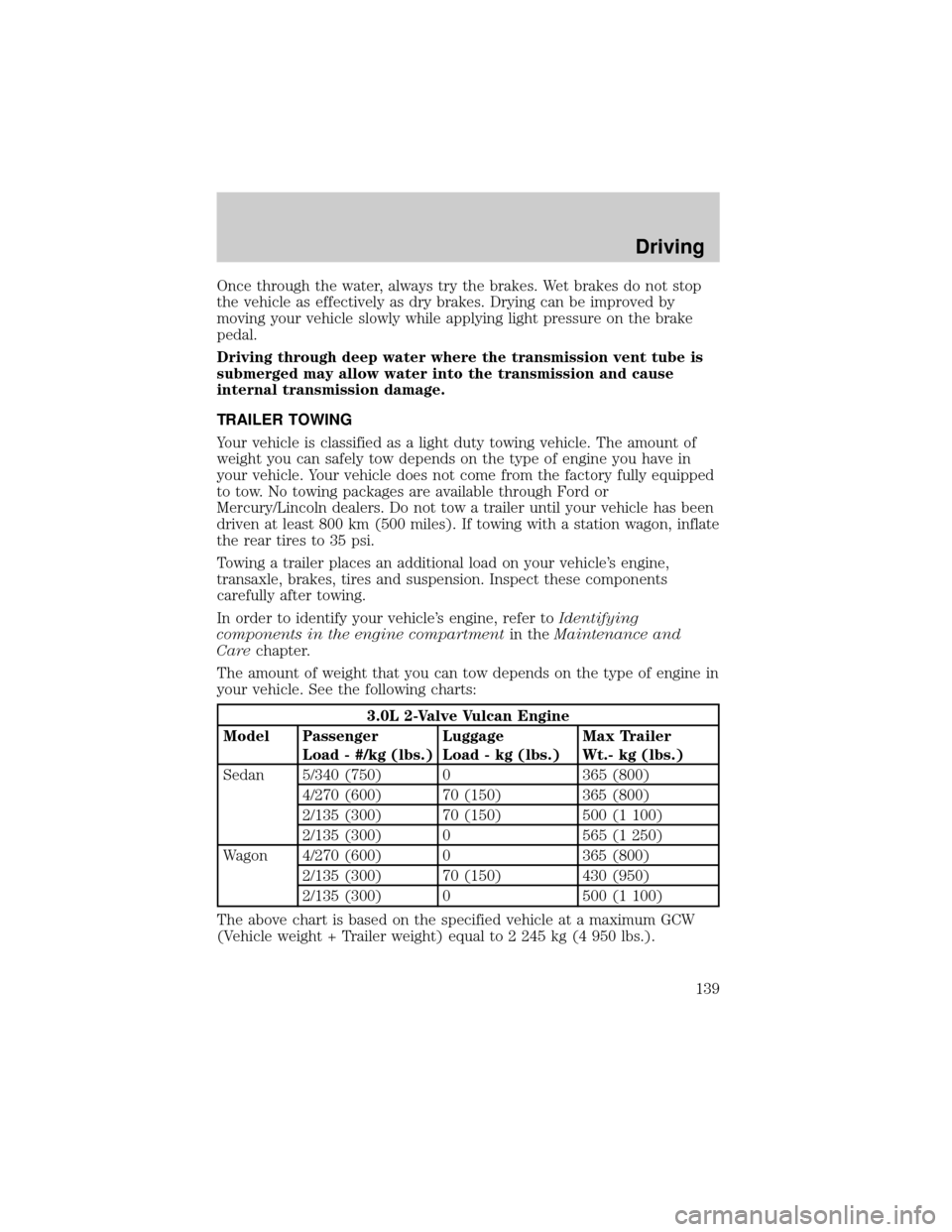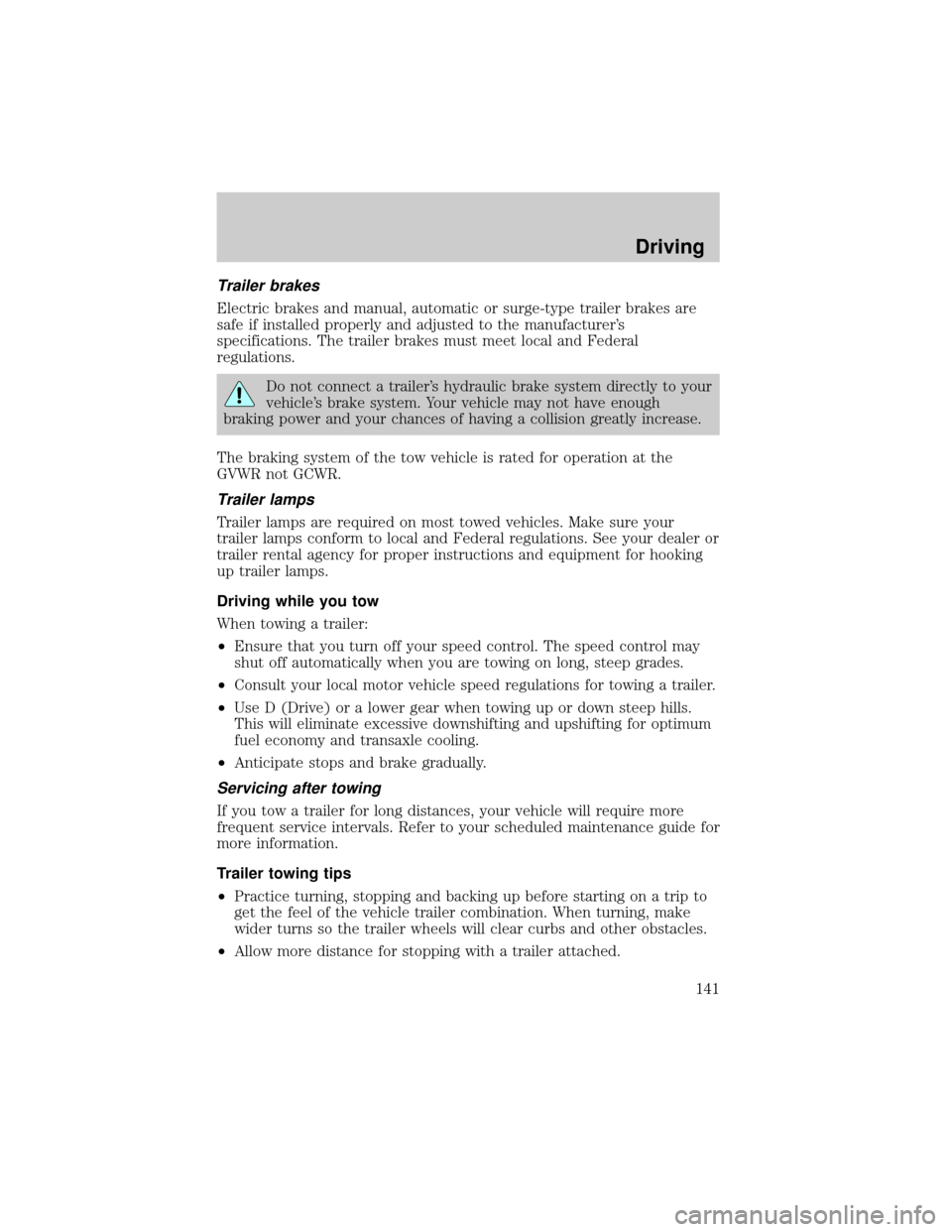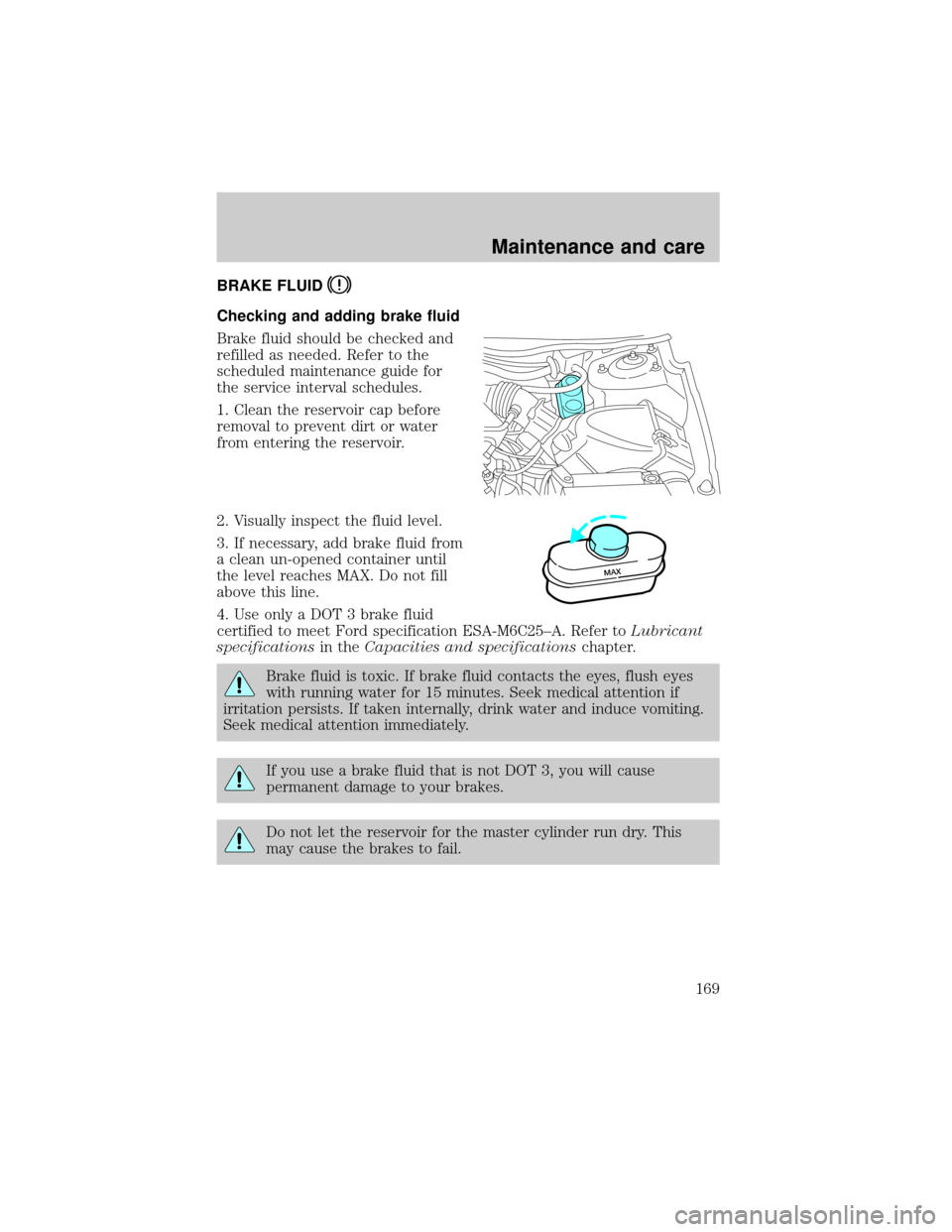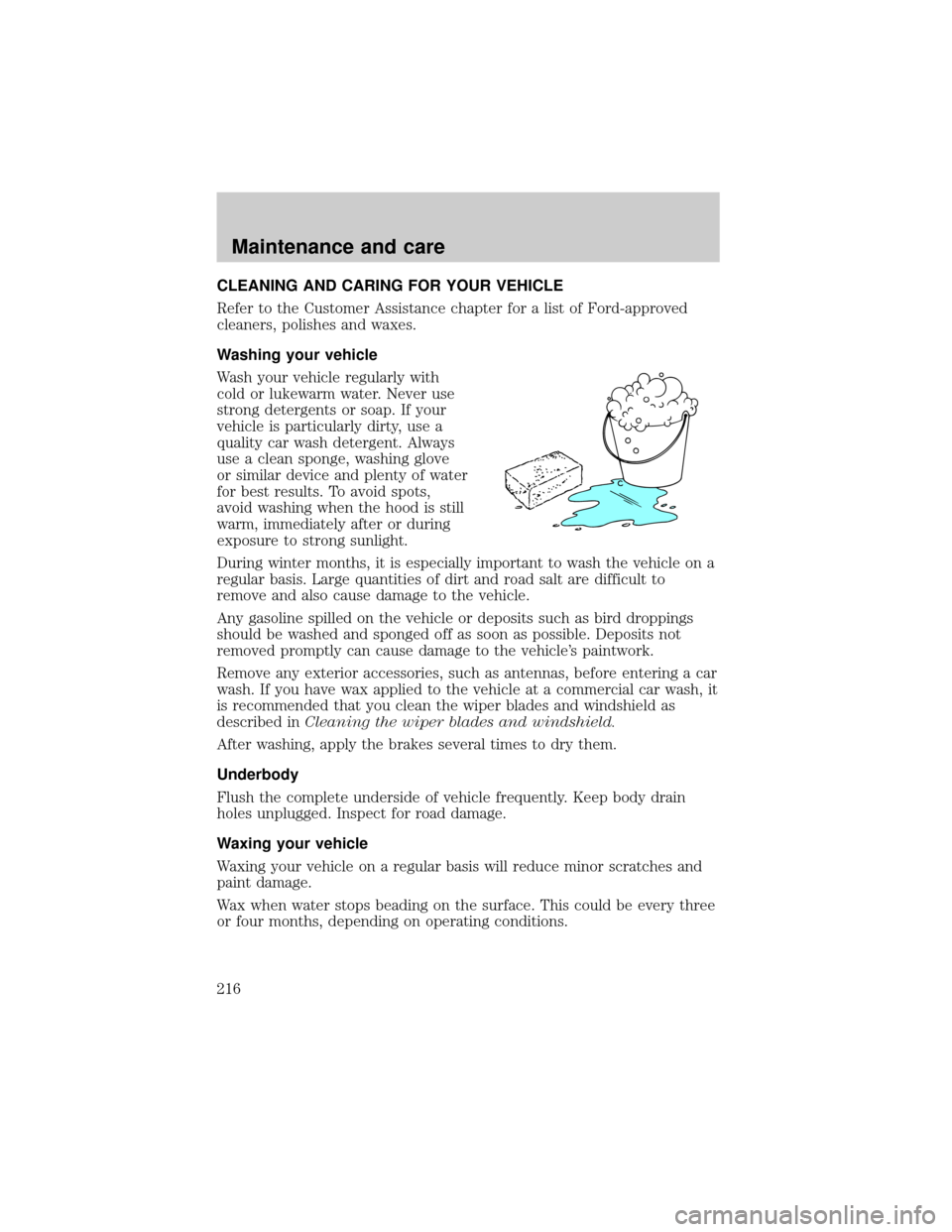2001 FORD TAURUS brakes
[x] Cancel search: brakesPage 139 of 256

Once through the water, always try the brakes. Wet brakes do not stop
the vehicle as effectively as dry brakes. Drying can be improved by
moving your vehicle slowly while applying light pressure on the brake
pedal.
Driving through deep water where the transmission vent tube is
submerged may allow water into the transmission and cause
internal transmission damage.
TRAILER TOWING
Your vehicle is classified as a light duty towing vehicle. The amount of
weight you can safely tow depends on the type of engine you have in
your vehicle. Your vehicle does not come from the factory fully equipped
to tow. No towing packages are available through Ford or
Mercury/Lincoln dealers. Do not tow a trailer until your vehicle has been
driven at least 800 km (500 miles). If towing with a station wagon, inflate
the rear tires to 35 psi.
Towing a trailer places an additional load on your vehicle's engine,
transaxle, brakes, tires and suspension. Inspect these components
carefully after towing.
In order to identify your vehicle's engine, refer toIdentifying
components in the engine compartmentin theMaintenance and
Carechapter.
The amount of weight that you can tow depends on the type of engine in
your vehicle. See the following charts:
3.0L 2-Valve Vulcan Engine
Model Passenger
Load - #/kg (lbs.)Luggage
Load - kg (lbs.)Max Trailer
Wt.- kg (lbs.)
Sedan 5/340 (750) 0 365 (800)
4/270 (600) 70 (150) 365 (800)
2/135 (300) 70 (150) 500 (1 100)
2/135 (300) 0 565 (1 250)
Wagon 4/270 (600) 0 365 (800)
2/135 (300) 70 (150) 430 (950)
2/135 (300) 0 500 (1 100)
The above chart is based on the specified vehicle at a maximum GCW
(Vehicle weight + Trailer weight) equal to 2 245 kg (4 950 lbs.).
Driving
139
Page 141 of 256

Trailer brakes
Electric brakes and manual, automatic or surge-type trailer brakes are
safe if installed properly and adjusted to the manufacturer's
specifications. The trailer brakes must meet local and Federal
regulations.
Do not connect a trailer's hydraulic brake system directly to your
vehicle's brake system. Your vehicle may not have enough
braking power and your chances of having a collision greatly increase.
The braking system of the tow vehicle is rated for operation at the
GVWR not GCWR.
Trailer lamps
Trailer lamps are required on most towed vehicles. Make sure your
trailer lamps conform to local and Federal regulations. See your dealer or
trailer rental agency for proper instructions and equipment for hooking
up trailer lamps.
Driving while you tow
When towing a trailer:
²Ensure that you turn off your speed control. The speed control may
shut off automatically when you are towing on long, steep grades.
²Consult your local motor vehicle speed regulations for towing a trailer.
²Use D (Drive) or a lower gear when towing up or down steep hills.
This will eliminate excessive downshifting and upshifting for optimum
fuel economy and transaxle cooling.
²Anticipate stops and brake gradually.
Servicing after towing
If you tow a trailer for long distances, your vehicle will require more
frequent service intervals. Refer to your scheduled maintenance guide for
more information.
Trailer towing tips
²Practice turning, stopping and backing up before starting on a trip to
get the feel of the vehicle trailer combination. When turning, make
wider turns so the trailer wheels will clear curbs and other obstacles.
²Allow more distance for stopping with a trailer attached.
Driving
141
Page 142 of 256

²If you are driving down a long or steep hill, shift to a lower gear. Do
not apply the brakes continuously, as they may overheat and become
less effective.
²The trailer tongue weight should be 10% of the loaded trailer weight.
²After you have traveled 80 km (50 miles), thoroughly check your
hitch, electrical connections and trailer wheel lug nuts.
²When stopped in traffic for long periods of time in hot weather, place
the gearshift in P (Park) and increase idle speed. This aids engine
cooling and air conditioner efficiency.
²Vehicles with trailers should not be parked on a grade. If you must
park on a grade, place wheel chocks under the trailer's wheels.
Recreational towing
Follow these guidelines for your specific powertrain combination to tow
your vehicle with all four wheels on the ground (such as behind a
recreational vehicle).
These guidelines are designed to ensure that your transmission is not
damaged due to insufficient lubrication.
All Front Wheel Drive (FWD) vehicles
An example of recreational towing is towing your vehicle behind a
motorhome. The following recreational towing guidelines are designed to
ensure that your transmission is not damaged. It is not recommended to
tow front wheel drive vehicles with the front drive wheels on the ground.
It is recommended to tow your vehicle with the drive wheels on a dolly
or two wheel car hauling trailer.
In case of a roadside emergency with a disabled vehicle (without access
to wheel dollies, car hauling trailer or flatbed transport vehicle) your
vehicle can be flat towed (all wheels on the ground) under the following
conditions:
²Place the transmission in N (Neutral).
²Maximum speed is 56 km/h (35 mph).
²Maximum distance is 80 km (50 miles).
Driving
142
Page 169 of 256

BRAKE FLUID
Checking and adding brake fluid
Brake fluid should be checked and
refilled as needed. Refer to the
scheduled maintenance guide for
the service interval schedules.
1. Clean the reservoir cap before
removal to prevent dirt or water
from entering the reservoir.
2. Visually inspect the fluid level.
3. If necessary, add brake fluid from
a clean un-opened container until
the level reaches MAX. Do not fill
above this line.
4. Use only a DOT 3 brake fluid
certified to meet Ford specification ESA-M6C25±A. Refer toLubricant
specificationsin theCapacities and specificationschapter.
Brake fluid is toxic. If brake fluid contacts the eyes, flush eyes
with running water for 15 minutes. Seek medical attention if
irritation persists. If taken internally, drink water and induce vomiting.
Seek medical attention immediately.
If you use a brake fluid that is not DOT 3, you will cause
permanent damage to your brakes.
Do not let the reservoir for the master cylinder run dry. This
may cause the brakes to fail.
MAX
Maintenance and care
169
Page 216 of 256

CLEANING AND CARING FOR YOUR VEHICLE
Refer to the Customer Assistance chapter for a list of Ford-approved
cleaners, polishes and waxes.
Washing your vehicle
Wash your vehicle regularly with
cold or lukewarm water. Never use
strong detergents or soap. If your
vehicle is particularly dirty, use a
quality car wash detergent. Always
use a clean sponge, washing glove
or similar device and plenty of water
for best results. To avoid spots,
avoid washing when the hood is still
warm, immediately after or during
exposure to strong sunlight.
During winter months, it is especially important to wash the vehicle on a
regular basis. Large quantities of dirt and road salt are difficult to
remove and also cause damage to the vehicle.
Any gasoline spilled on the vehicle or deposits such as bird droppings
should be washed and sponged off as soon as possible. Deposits not
removed promptly can cause damage to the vehicle's paintwork.
Remove any exterior accessories, such as antennas, before entering a car
wash. If you have wax applied to the vehicle at a commercial car wash, it
is recommended that you clean the wiper blades and windshield as
described inCleaning the wiper blades and windshield.
After washing, apply the brakes several times to dry them.
Underbody
Flush the complete underside of vehicle frequently. Keep body drain
holes unplugged. Inspect for road damage.
Waxing your vehicle
Waxing your vehicle on a regular basis will reduce minor scratches and
paint damage.
Wax when water stops beading on the surface. This could be every three
or four months, depending on operating conditions.
Maintenance and care
216
Page 243 of 256

A
Accessory delay ..........................63
Air bag supplemental restraint
system ........................104, 106, 110
and child safety seats ............107
description ......................106, 110
disposal ....................................112
driver air bag ..........105, 109, 111
indicator light ...................13, 108
operation .................105, 109, 111
passenger air bag ...105, 109, 111
side air bag ..............................110
Air cleaner filter .......................222
Air conditioning ..........................19
automatic temperature
control system ..........................22
Air filter, cabin ..........................180
Antifreeze (see Engine
coolant) .....................................171
Anti-lock brake system (see
Brakes) ..............................127±128
Anti-theft system ........................73
arming the system ....................73
disarming a triggered system ..75
warning light .............................11
Audio system (see Radio) .........30
Automatic transaxle .................132
driving with .............................134
fluid, adding ............................178
fluid, checking ........................178
fluid, refill capacities ..............223
fluid, specification ..................226
Auxiliary power point .................29
Axle
lubricant specifications ..........224B
Battery .......................................185
acid, treating emergencies .....185
charging system
warning light .............................13
jumping a disabled battery ....156
maintenance-free ....................185
replacement, specifications ...222
servicing ..................................185
Belt minder ...............................100
Brakes ........................................127
anti-lock ...........................127±128
anti-lock brake system
(ABS) warning light .........12, 128
brake warning light ..................12
fluid, checking and adding ....169
fluid, refill capacities ..............223
fluid, specifications .........224, 226
lubricant specifications ..224, 226
parking ....................................129
pedals (see Power adjustable
foot pedals) ...............................51
shift interlock ..........................132
Break-in period .............................3
C
Capacities for refilling fluids ....223
Cargo area shade ........................68
Cargo cover .................................67
Cargo net .....................................67
CD changer .................................47
Cellular telephone
Wireless Interface Module .......60
Certification Label ....................228
Child safety restraints ..............113
child safety belts ....................113
Index
243
Page 246 of 256

high beam .............................8, 17
replacing bulbs .......................204
turning on and off ....................17
warning chime ..........................14
Heating ........................................19
heating and air conditioning
system .......................................19
Hood ..........................................163
I
Ignition .................................52, 226
Infant seats
(see Safety seats) .....................114
Inspection/maintenance (I/M)
testing ........................................203
Instrument panel
cleaning ...................................220
cluster ..................................8, 220
lighting up panel and interior .18
location of components ..............8
J
Jack ............................................152
positioning ...............................152
storage .....................................152
Jump-starting your vehicle ......156
K
Keyless entry system .................76
autolock .....................................78
keypad .......................................76
locking and unlocking doors ....77
programming entry code .........76
Keys .................................79±80, 82
key in ignition chime ...............14
positions of the ignition ...........52L
Lamps
autolamp system .......................18
bulb replacement
specifications chart ................213
cargo lamps ...............................18
daytime running light ...............17
headlamps .................................17
headlamps, flash to pass ..........17
instrument panel, dimming .....18
interior lamps .....................58±59
replacing
bulbs ........203±204, 207±209, 211
Lane change indicator
(see Turn signal) ........................56
Liftgate ..................................66, 71
Lights, warning and indicator ......8
air bag ........................................13
anti-lock brakes (ABS) ....12, 128
anti-theft ...................................11
brake ..........................................12
charging system ........................13
check coolant ............................12
cruise indicator .........................12
door ajar ......................................9
fuel cap light ...............................9
high beam ...................................8
low coolant ................................11
low fuel ......................................11
oil pressure ...............................13
safety belt ...................................9
service engine soon ..................10
speed control ............................56
traction control active ................8
turn signal indicator ...................8
Load limits .................................137
GAWR ......................................137
GVWR ......................................137
trailer towing ..........................137
Index
246